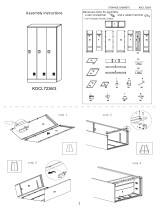
Installing Your Heater
Vent Installation
This heater must be properly connected to a venting system. This
heater is equipped with a vent safety shutoff system to protect
against improper venting of combustion products. Tampering with
or removal of this control will void the limited warranty and can
result in carbon monoxide (CO) poisoning and possible death.
WARNING: Operation of this heater, when not
connected to a properly installed and maintained
venting system or tampering with the vent safety
shutoff system, can result in carbon monoxide (CO)
poisoning and possible death.
This appliance needs fresh air for safe operation and must be
installed so there are provisions for adequate combustion and
ventilation air. This room heater is equipped with a vent safety
switch. The vent safety switch will cause gas flow to the main
burner to shutoff due to improper venting or a blocked flue. If the
vent safety switch continues to shut off the gas flow, a qualified
service person must be contacted to inspect for improper venting,
blockage in the vent pipe or the vent safety switch for being
defective.
WARNING: Do not bypass the vent safety shutoff
switch. To do so could expose the consumer to
property damage, personal injury or possible death.
WARNING: Danger of illness, bodily injury or death.
This heater and any other fuel burning appliance
must be provided with enough fresh air for proper
combustion and ventilation of flue gases. Most
homes will require that outside air be supplied into
the heater area.
1. An effective flue is necessary to carry off water vapor, carbon
monoxide (CO), carbon dioxide (CO2), and other products of
combustion. For proper venting, follow the following basic
rules for gravity venting, which are:
a. Keep the flue gases hot.
b. Follow the vent manufacturer's installation instructions.
c. Select the proper vent size.
d. Provide constant fresh air replacement.
2. For new installation, it is recommended that a Type “B” vent in
accordance with its’ listing be used. A Type “B” vent is one
made of non-combustible, corrosion resistant material of
sufficient thickness, cross sectional area and heat insulating
quality to avoid excess temperatures on adjacent combustible
material and certified by a nationally recognized testing
agency. Existing brick flues should be lined to provide an
effective vent. Brick chimneys, even in good repair, may be too
large and will not provide sufficient draft to effectively vent a
heater.
3. Use vent pipe of the same size as the outlet on back of heater.
In no case should a different size vent be used. Single wall
vent pipe may be attached directly to the draft hood of the
room heater when a clearance of 2-1/2 inches (64mm) is
maintained between the single wall vent pipe and the
combustible wall of the room in which the room heater is
located. Use double wall vent pipe for clearances less than 2-
1/2 inches (64mm) to combustibles.
4. Avoid a horizontal run to the vent pipe whenever possible.
When a horizontal run is necessary, the pipe must pitch
upward at least 1/4 inch per foot. It must be supported
securely and joints fastened by sheet metal screws or rivets.
Under no circumstances should the vent run downhill.
5. Never put a damper or barometric draft control in a gas vent
pipe.
6. Never end a vent in an open attic or run a vent through a wall
to the outside without extending it upward above the roof.
7. Always terminate the vent with an approved vent cap.
8. ALWAYS SECURE THE VENT PIPE TO THE OUTLET ON
THE BACK OF THE HEATER WITH A SHEET METAL
SCREW.
9. The flue pipe should extend through the wall of a chimney to
be flush with the inner wall.
10. The flue pipe must be adequately supported by metal strips.
11. For the flue pipe running through walls and roofs, use B type
(1 inch (25mm) clearance to combustibles) vent pipe.
12. Vents should extend at least 2 feet (.6m) above the roof and
above any object or nearby building within 10 feet (3m).
13. Open tees should not be used in the flue pipe.
14. The heater must not be connected to a chimney flue that is
servicing a separate solid-fuel burning appliance.
15. For proper venting, do not attach a 90 degree elbow directly to
the draft diverter. It is recommended to attach 2 feet (.6m) of
straight vent pipe before an elbow is used. Use 45 degree
elbows if possible. Run flue pipe as direct as possible with not
more than two elbows.
16. The use of more than one appliance per vent system may
cause the vent safety shutoff device to shut off the heater due
to the cooling of vent temperatures through the draft diverter
of the second appliance.
17. The vent safety shutoff may shut down the heater if a too large
or an unlined, masonry chimney is used. The vent may not
warm quickly enough to get adequate vent action in a chimney
before the shutoff device will shut down the heater. If this is
the case, it is recommended lining the chimney with proper
size type “B” vent pipe or type “B” chimney liner.
18. Single-wall metal pipe should not be used outdoors in cold
climates or venting gas equipment. If the vent is installed
directly outside, the cold pipe may delay the venting and
cause the heater to shut-off by the vent safety switch. To
prevent this problem, as well as condensation of flue products,
an insulated enclosure is recommended. Use type B, vent
pipe and maintain at least a one inch clearance to
combustibles. Use a metal thimble to protect vent pipe as it
passes through combustibles.























